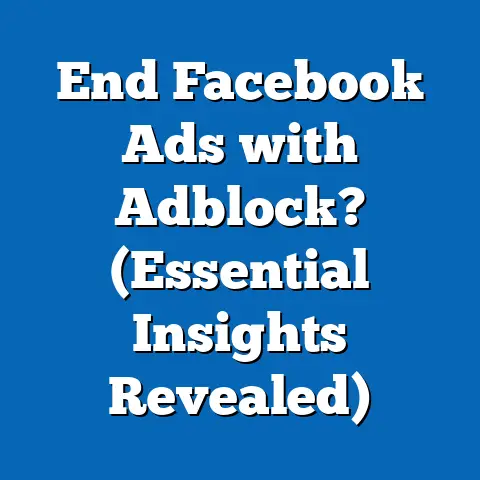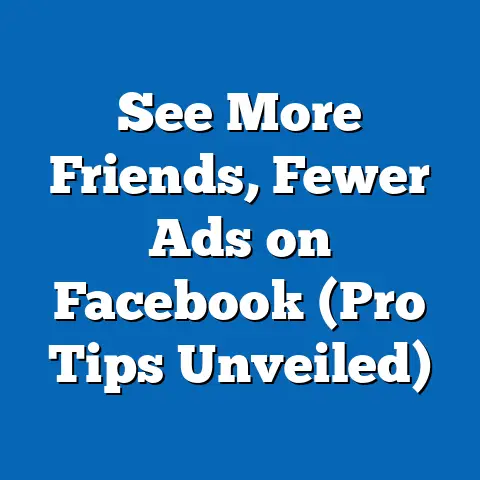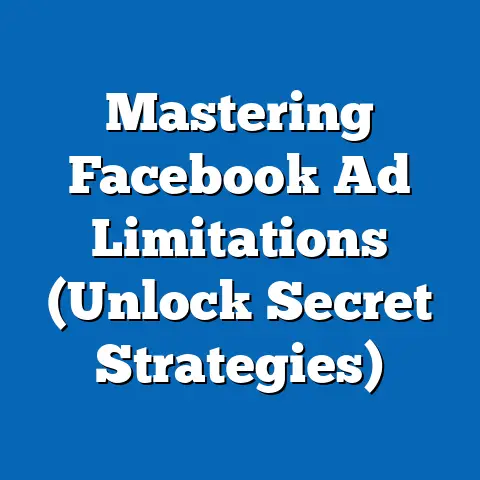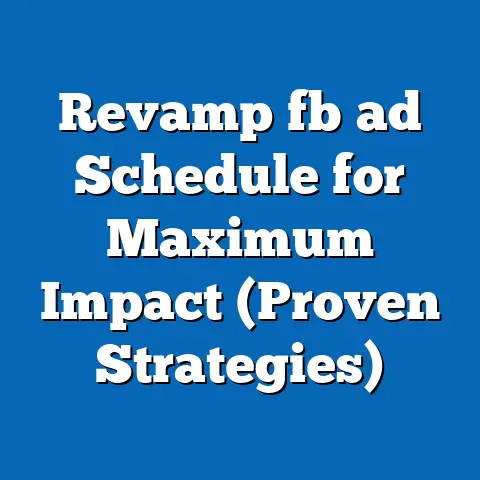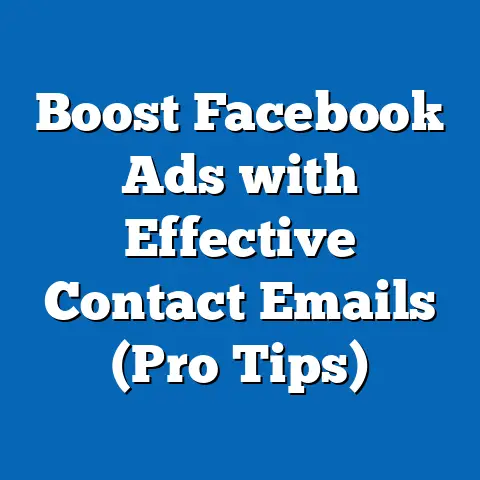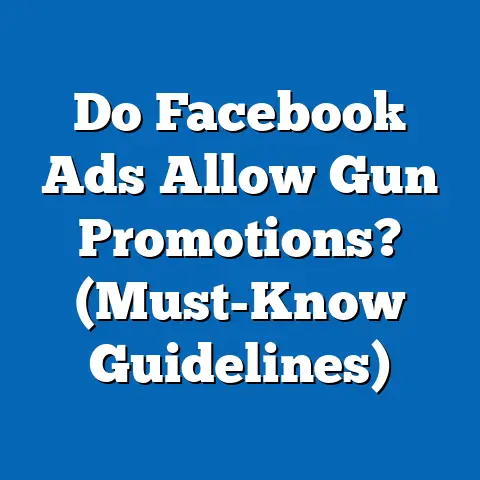Reduza Seu CPM no Facebook Ads (Estratégias Comprovadas)
The world of Facebook Ads is a constantly evolving landscape, and as advertisers, we’re always looking for an edge. One metric that sits at the heart of our success is CPM, or Cost Per Mille (Cost Per Thousand Impressions). It’s not just a number; it’s a vital sign that tells us how efficiently our ads are being delivered to our target audience. I believe that mastering CPM is the key to unlocking significant savings and maximizing the impact of your campaigns.
For me, it all started when I was running a campaign for a local bakery. We were promoting a new line of artisanal breads, and while the ads looked great and the targeting seemed spot-on, the CPM was through the roof. I was spending a fortune just to get our ads seen, and the conversions weren’t justifying the expense. That’s when I dove deep into understanding CPM and how to optimize it.
Reducing CPM isn’t just about pinching pennies; it’s about creating ads that resonate with your audience, targeting the right people, and continuously refining your approach. It’s about understanding that high-quality content, precise audience targeting, and relentless testing are the cornerstones of achieving lower CPMs.
In this guide, I’m going to walk you through proven strategies that I’ve personally used to drastically reduce CPM on Facebook Ads, turning what was once a cost center into a powerful engine for growth. Get ready to transform your Facebook advertising and unlock a new level of efficiency and profitability.
Compreendendo o CPM no Facebook Ads
Let’s start with the basics. CPM, or Cost Per Mille (Mille is Latin for thousand), represents the cost you pay for every 1,000 impressions your ad receives. In simpler terms, it’s how much Facebook charges you each time your ad is shown to 1,000 people.
How does it work within Facebook’s advertising ecosystem? Facebook operates on an auction system. When an ad slot becomes available, Facebook analyzes all the ads targeting that user and determines which ad to show based on factors like bid amount, ad quality, and relevance. The higher your bid and the better your ad, the more likely you are to win the auction. However, even if you win, a high CPM can eat away at your budget quickly.
Several factors influence CPM rates:
- Competition: The more advertisers targeting the same audience, the higher the CPM. Think about it: during peak seasons like Black Friday or Christmas, CPMs tend to skyrocket because everyone is vying for the same eyeballs.
- Ad Quality: Facebook rewards high-quality ads with lower CPMs. Ad quality is determined by factors like relevance, engagement rate (likes, comments, shares), and landing page experience.
- Audience Targeting: Targeting a broad audience is often cheaper, but it can also lead to lower conversion rates. A highly specific and engaged audience might cost more to reach, but the return on investment is usually much higher.
- Ad Placement: The placement of your ad (e.g., Facebook News Feed, Instagram Stories, Audience Network) can also affect CPM. Some placements are more competitive than others.
- Time of Year: As mentioned earlier, seasonal trends and events can significantly impact CPM.
Data and statistics paint a clear picture of why advertisers need to pay attention to CPM. According to industry reports, CPMs have generally been on the rise in recent years, driven by increased competition and changes in Facebook’s algorithm. In 2023, the average CPM across all industries was around $12-$15, but this can vary wildly depending on your niche and targeting.
For example, I remember working with a client in the finance industry. Their initial CPM was nearly $20 because they were targeting a highly competitive audience with generic ads. By refining their targeting and creating more engaging content, we managed to bring the CPM down to under $10, significantly boosting their ROI.
Key Takeaway: Understanding CPM is the first step to controlling your advertising costs on Facebook. By recognizing the factors that influence CPM, you can start to strategize ways to lower it.
Next Steps: Analyze your current campaigns and note your CPM. Identify potential areas where you can improve your ad quality, targeting, or bidding strategy.
Estratégia 1 – Otimização do Público-Alvo
One of the most effective strategies for lowering CPM is to optimize your audience targeting. Think of it like this: showing your ad to the right people is like casting a fishing net in a pond teeming with fish. Show it to the wrong people, and you’re just throwing money away.
Precise audience targeting is crucial because it increases the relevance of your ad, leading to higher engagement rates and lower CPMs. Facebook rewards ads that are relevant to the user, so the more targeted your audience, the more likely your ad is to perform well.
Here’s how to use Facebook’s Audience Insights tool to identify and segment audiences effectively:
- Access Audience Insights: Go to Ads Manager and click on “Audience Insights” under the “Tools” menu.
- Choose Your Audience: You can choose between “Everyone on Facebook” or “People connected to your Page.” If you’re starting from scratch, “Everyone on Facebook” is a good option.
- Explore Interests: Enter interests related to your product or service. Audience Insights will then provide demographic data, page likes, location data, and activity data for people interested in those topics.
- Refine Your Audience: Use the filters on the left-hand side to refine your audience based on age, gender, location, interests, behaviors, and connections.
- Analyze the Data: Pay attention to the “Page Likes” and “Demographics” tabs. These will give you insights into what other pages your audience likes and their age and gender distribution.
- Save Your Audience: Once you’ve identified a promising audience, save it for use in your ad campaigns.
Creating custom audiences and lookalike audiences can further enhance ad relevance.
- Custom Audiences: These are audiences you create based on data you already have, such as customer lists, website visitors, or app users. Uploading a customer list, for example, allows you to target your existing customers with specific ads.
- Lookalike Audiences: These are audiences that Facebook creates based on your custom audiences. Facebook identifies users who share similar characteristics and behaviors with your existing customers or website visitors, allowing you to reach new potential customers who are likely to be interested in your product or service.
I remember working with an e-commerce store that sold handmade jewelry. Their initial audience targeting was quite broad, resulting in a high CPM and low conversion rate. By creating a custom audience of their existing customers and then generating a lookalike audience based on that, we were able to target a highly relevant group of people who were much more likely to make a purchase. The result was a significant decrease in CPM and a boost in sales.
Key Takeaway: Precise audience targeting is a cornerstone of reducing CPM. Leverage Facebook’s Audience Insights tool and create custom and lookalike audiences to reach the right people with your ads.
Next Steps: Spend time researching your target audience using Facebook’s Audience Insights tool. Create custom audiences based on your existing customer data and generate lookalike audiences to expand your reach.
Estratégia 2 – Criatividade e Qualidade do Anúncio
The quality and creativity of your ads play a pivotal role in determining your CPM. Think of your ad as a tiny advertisement in a crowded marketplace. If it’s dull and uninspired, it’ll get lost in the noise. But if it’s engaging and visually appealing, it’ll grab people’s attention and make them want to learn more.
Facebook rewards high-quality ads with lower CPMs because they provide a better user experience. Ads that are relevant and engaging are more likely to be liked, commented on, and shared, which signals to Facebook that they are valuable to users.
Here are some tips on creating engaging visuals and compelling ad copy that resonates with your target audience:
- Use High-Quality Images and Videos: Visuals are the first thing people see, so make sure they’re eye-catching and professional-looking. Avoid blurry or pixelated images.
- Tell a Story: Craft ad copy that tells a compelling story and connects with your audience on an emotional level.
- Focus on Benefits, Not Features: Highlight the benefits of your product or service, rather than just listing its features.
- Use a Clear Call to Action: Tell people what you want them to do, whether it’s visiting your website, making a purchase, or signing up for a newsletter.
- Keep It Concise: People have short attention spans, so get to the point quickly.
A/B testing different ad creatives is essential to find what works best. This involves creating multiple versions of your ad with different visuals, headlines, body text, and calls to action, and then testing them against each other to see which performs best.
I remember working with a clothing retailer whose ads were consistently underperforming. Their CPM was high, and their click-through rate was low. We decided to run an A/B test with two different ad creatives: one featuring a professional model wearing their clothes, and the other featuring real customers. To our surprise, the ad with real customers performed much better, resulting in a lower CPM and a higher click-through rate. This taught us that authenticity resonates more with their target audience than polished perfection.
Key Takeaway: The quality and creativity of your ads directly impact your CPM. Invest time and effort in creating engaging visuals and compelling ad copy that resonates with your target audience.
Next Steps: Review your current ad creatives and identify areas for improvement. Run A/B tests with different visuals, headlines, body text, and calls to action to see which performs best.
Estratégia 3 – Otimização de Campanhas e Testes Contínuos
Continuous optimization is the heart and soul of successful Facebook advertising. It’s about constantly monitoring your campaigns, analyzing the data, and making adjustments to improve performance. And when it comes to CPM, it’s a game-changer.
Think of it like tuning a musical instrument. You wouldn’t just set it up once and expect it to stay in tune forever. You need to regularly check it, make adjustments, and fine-tune it to ensure it sounds its best. The same goes for your Facebook ad campaigns.
Continuous optimization plays a vital role in reducing CPM because it allows you to identify and eliminate inefficiencies, improve ad relevance, and refine your targeting.
Here are some different types of tests advertisers can conduct:
- Ad Placement Testing: Test different ad placements (e.g., Facebook News Feed, Instagram Stories, Audience Network) to see which performs best for your target audience.
- Ad Format Testing: Experiment with different ad formats (e.g., image ads, video ads, carousel ads) to see which is most engaging.
- Bidding Strategy Testing: Test different bidding strategies (e.g., lowest cost, target cost, bid cap) to see which delivers the best results for your budget.
- Audience Testing: Test different audiences to see which is most responsive to your ads.
Here’s a framework for setting up an effective testing schedule and measuring results:
- Define Your Goals: What do you want to achieve with your testing? Are you trying to lower your CPM, increase your click-through rate, or boost your conversion rate?
- Choose Your Variables: What variables do you want to test? Start with one or two variables at a time to keep things manageable.
- Create Your Test Ads: Create multiple versions of your ad with different values for the variables you’re testing.
- Set Up Your Campaign: Set up your campaign in Ads Manager and specify the audiences, placements, and bidding strategies you want to use.
- Run Your Test: Let your test run for a sufficient period of time to gather enough data (usually at least a week).
- Analyze Your Results: Analyze the data to see which ad version performed best.
- Implement Your Findings: Implement the winning ad version in your ongoing campaigns.
- Repeat: Continuously test and optimize your campaigns to stay ahead of the curve.
Analyzing data is crucial for making informed decisions. Pay attention to metrics like CPM, click-through rate (CTR), conversion rate, and cost per conversion. These metrics will give you insights into how well your ads are performing and where you can make improvements.
I recall working with a local restaurant that was struggling to attract new customers. Their CPM was high, and their ads weren’t generating enough traffic. We decided to run a series of tests to optimize their campaigns. We started by testing different ad placements and discovered that their ads performed much better on Instagram than on Facebook. We then tested different ad formats and found that video ads were more engaging than image ads. By continuously testing and optimizing their campaigns, we were able to significantly lower their CPM and increase their website traffic.
Key Takeaway: Continuous optimization is essential for reducing CPM. Set up an effective testing schedule, analyze the data, and make adjustments to improve your ad performance.
Next Steps: Review your current campaigns and identify areas where you can run tests. Start with simple tests, like testing different ad placements or ad formats.
Estratégia 4 – Utilização de Retargeting
Retargeting is a powerful strategy that can significantly lower your CPM by targeting users who have already engaged with your brand. It’s like giving a gentle nudge to someone who’s already shown interest in what you have to offer.
The concept of retargeting is simple: you track users who visit your website or interact with your content on Facebook, and then you show them targeted ads based on their behavior. This allows you to reach people who are already familiar with your brand, making them more likely to convert.
Retargeting leads to lower CPM because you’re targeting a highly relevant audience. These users have already shown interest in your product or service, so they’re more likely to engage with your ads, resulting in higher engagement rates and lower CPMs.
Here’s how to set up retargeting campaigns on Facebook:
- Install the Facebook Pixel: The Facebook Pixel is a piece of code that you install on your website to track user behavior. You can find the Pixel code in Ads Manager under the “Events Manager” menu.
- Create Custom Audiences: Create custom audiences based on specific actions users take on your website, such as visiting a particular page, adding an item to their cart, or making a purchase.
- Create Retargeting Ads: Create ads that are specifically tailored to the users in your custom audiences. For example, if someone added an item to their cart but didn’t complete the purchase, you could show them an ad reminding them about the item and offering a discount.
- Set Up Your Campaign: Set up your campaign in Ads Manager and target your custom audiences.
I worked with an online bookstore that was struggling with high cart abandonment rates. We implemented a retargeting strategy that showed ads to users who had added books to their cart but didn’t complete the purchase. The ads featured the books they had added to their cart, along with a special discount code. This retargeting campaign was incredibly successful, resulting in a significant decrease in cart abandonment rates and a boost in sales. Plus, their CPM for these retargeted ads was noticeably lower than their broader prospecting campaigns.
Key Takeaway: Retargeting is a highly effective strategy for lowering CPM. Target users who have already engaged with your brand to increase ad relevance and engagement rates.
Next Steps: Install the Facebook Pixel on your website and create custom audiences based on user behavior. Set up retargeting campaigns that are specifically tailored to these audiences.
Conclusion
Lowering your CPM on Facebook Ads isn’t just about saving money; it’s about maximizing the effectiveness of your advertising efforts. By implementing the strategies I’ve shared in this guide, you can create more relevant ads, target the right audiences, and continuously optimize your campaigns to achieve lower CPMs and higher ROI.
Remember, it’s not simply about minimizing costs, but about maximizing the effectiveness of your ad campaigns. Embrace the power of audience optimization, creative excellence, continuous testing, and retargeting to transform your Facebook advertising.
I encourage you to take action today and implement these strategies in your own campaigns. Monitor your CPM results closely and make adjustments as needed to ensure ongoing success. The world of Facebook Ads is constantly evolving, so it’s important to stay informed and adapt your strategies accordingly.
By mastering CPM, you’ll not only save money but also unlock a new level of efficiency and profitability in your Facebook advertising. So go out there, experiment, and watch your CPM plummet! Good luck!

